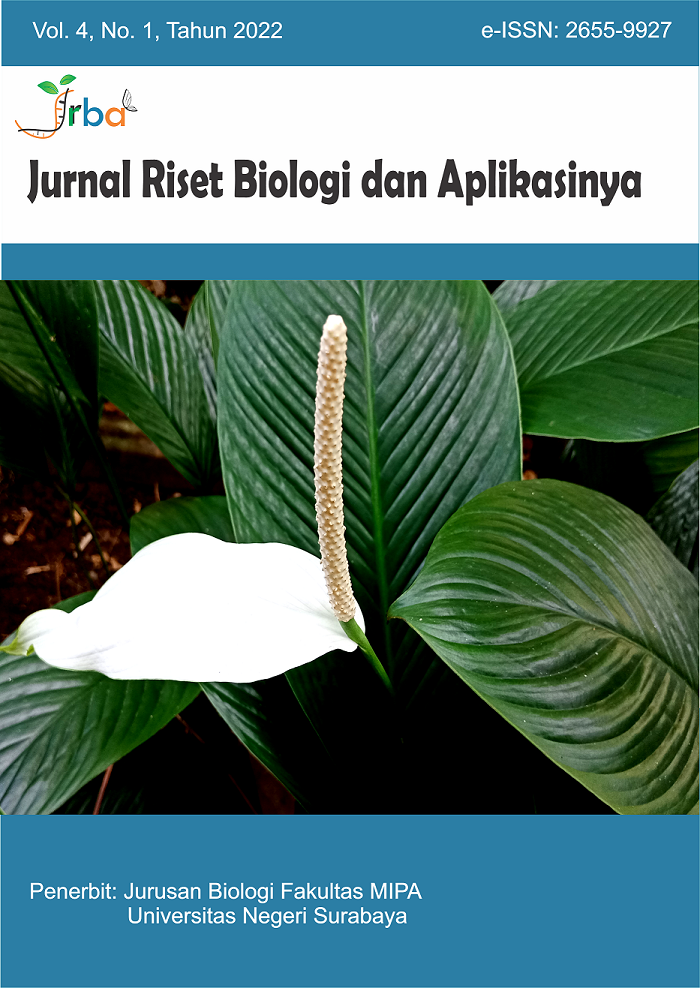In Silico Study of Secondary Metabolites in Dendrobium spp. as SARS-CoV-2 Antivirus on Main Protease (Mpro)
DOI:
https://doi.org/10.26740/jrba.v4n1.p19-25Keywords:
antiviral, docking, Dendrobium, Mpro, SARS-CoV-2Abstract
Infection and deaths cases by SARS-CoV-2 still increase and have not decreased significantly. Main protease (Mpro) is playing an important role in the replication of SARS-CoV-2 life cycle and causes of rapid transmission. Natural compounds are potential to be antiviral candidates with high bioavailability and low cytotoxicity. Orchids of Dendrobium genus have high diversity in Indonesia. Dendrobium has been used as traditional Chinese medicine and contains a group of secondary metabolites with antiviral activity. This study aimed to determine the potential of secondary metabolites of Dendrobium orchids as antiviral candidates against Mpro SARS-CoV-2 with in silico molecular docking. Secondary metabolites obtained from the KNApSAck and PubChem act as ligands. N3 inhibitors as native ligands were obtained from the RCSB. Mpro SARS-CoV-2 (6LU7) as a target macromolecule. Molecular docking was carried out using the online Covid-19 Docking Server using AutoDock Vina device. The most negative binding affinity value for each ligand compared to the native ligand binding affinity. Visualization with Discovery Studio software has been used to observe the protein amino acid residues contact for each ligand. The binding affinity of the native ligand inhibitor N3 is -7.5 kcal/mol. Based on the results of Mpro docking, three phytochemicals from Dendrobium spp., i.e., dendrocandin B, denthyrsinone, and denthyrsinol compounds have binding affinities of -7.7 kcal/mol, -7.9 kcal/mol, and -8.1 kcal/mol, respectively. It can be concluded that in Dendrobium orchid, denthyrsinol has the highest chance of binding so it has the potential to inhibit the Mpro SARS-CoV-2 activity.
References
Barik, A., Rai, G., & Modi, G. (2020). Molecular docking and binding mode analysis of selected FDA approved drugs against COVID-19 selected key protein targets: An effort towards drug repurposing to identify the combination therapy to combat COVID-19. http://arxiv.org/abs/2004.06447
Chen, D., Oezguen, N., Urvil, P., Ferguson, C., Dann, S. M., & Savidge, T. C. (2016). Regulation of protein-ligand binding affinity by hydrogen bond pairing. Science Advances, 2(3). https://doi.org/10.1126/sciadv.1501240
Coronaviridae Study Group of the International Committee on Taxonomy of Viruses. (2020). The species severe acute respiratory syndrome-related coronavirus: classifying 2019-nCoV and naming it SARS-CoV-2. Nature microbiology, 5(4): 536-544
Cui, W., Y. Kailin, and Y. Haitao. (2020). Recent Progress in the Drug Development Targeting SARS-CoV-2 Main Protease as Treatment for COVID-19. Frontiers in Molecular Biosciences, 7(398): 1-10. doi: 10.3389/fmolb.2020.616341
Griffin, J. W. D. (2020). SARS-CoV and SARS-CoV-2 main protease residue interaction networks change when bound to inhibitor N3. Journal of Structural Biology, 211(3), 107575. https://doi.org/10.1016/j.jsb.2020.107575
Hamid, S., Mir, M. Y., & Rohela, G. K. (2020). Novel coronavirus disease (COVID-19): a pandemic (epidemiology, pathogenesis and potential therapeutics). New Microbes and New Infections, 35, 100679. https://doi.org/10.1016/j.nmni.2020.100679
Khaerunnisa, S., Kurniawan, H., Awaluddin, R., Suhartati, S., & Soetjipto, S. (2020). Potential Inhibitor of COVID-19 Main Protease (Mpro) From Several Medicinal Plant Compounds by Molecular Docking Study Molecular Docking, ADME-Toxicity Prediction, and Evaluation of Curcumin Derivative Compound as Inhibitor Inflamation on Rheumathoid Arth. Preprints, March. https://doi.org/10.20944/preprints202003.0226.v1
Lam, Y., Ng, T. B., Yao, R. M., Shi, J., Xu, K., Sze, S. C. W., & Zhang, K. Y. (2015). Evaluation of chemical constituents and important mechanism of pharmacological biology in Dendrobium plants. Evidence-Based Complementary and Alternative Medicine, 2015. https://doi.org/10.1155/2015/841752
Pandey, P., Rane, J. S., Chatterjee, A., Kumar, A., & Ray, S. (2020). Targeting SARS-CoV-2 Spike Protein of COVID-19 with Naturally Occurring Phytochemicals: An in Silco Study for Drug Development. ChemRxiv. https://doi.org/10.26434/chemrxiv.12094203.v1
Purwaniati, and A. Asnawi. (2020). Target Kerja Obat Antivirus Covid-19: Review Drug Target of Antivirus Covid-19: Review. Jurnal Farmagazine, 7(2): 30-42
Rachmania, R. A., Supardi, and O. A. Larasati. (2015). In Silico Analysis of Diterpenoid Lactone Compounds of Bitter Herbs (Andrographis paniculate Nees) on Alpha-Glucosidase Receptor as Antidiabetic Type II Agents. PHARMACY,12(2): 210-222
Rane, J. S., Chatterjee, A., Kumar, A., & Ray, S. (2020). Targeting SARS-CoV-2 Spike Protein of COVID-19 with Naturally Occurring Phytochemicals: An in Silco Study for Drug Development. ChemRxiv, https://doi.org/10.26434/chemrxiv.12094203.v1
Sumon, T. A., Hussain, M. A., Hasan, M. T., Hasan, M., Jang, W. J., Bhuiya, E. H., Chowdhury, A. A. M., Sharifuzzaman, S. M., Brown, C. L., Kwon, H. J., & Lee, E. W. (2021). A Revisit to the Research Updates of Drugs, Vaccines, and Bioinformatics Approaches in Combating COVID-19 Pandemic. Frontiers in Molecular Biosciences, 7. https://doi.org/10.3389/fmolb.2020.585899
Trott, O., & Olson, A. J. (2009). AutoDock Vina: Improving the speed and accuracy of docking with a new scoring function, efficient optimization, and multithreading. Journal of Computational Chemistry, 31(2), NA-NA. https://doi.org/10.1002/jcc.21334
Vicidomini, C., Roviello, V., & Roviello, G. N. (2021). In silico investigation on the interaction of chiral phytochemicals from opuntia ficus-indica with sars-cov-2 mpro. Symmetry, 13(6). https://doi.org/10.3390/sym13061041
Wang, C., Horby, P.W., Hayden, F.G. and Gao, G.F. (2020). A novel coronavirus outbreak of global health concern. The lancet, 395 (10223): 470-473
Downloads
Published
How to Cite
Issue
Section
License
Copyright (c) 2022 Jurnal Riset Biologi dan Aplikasinya

This work is licensed under a Creative Commons Attribution-NonCommercial 4.0 International License.
 Abstract views: 875
,
Abstract views: 875
, PDF Downloads: 241
PDF Downloads: 241












